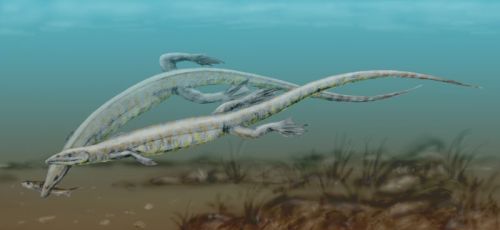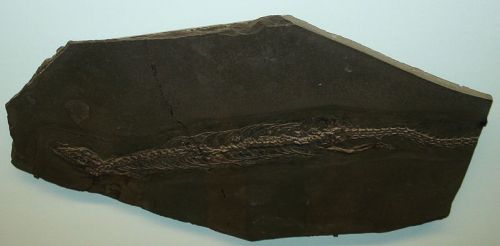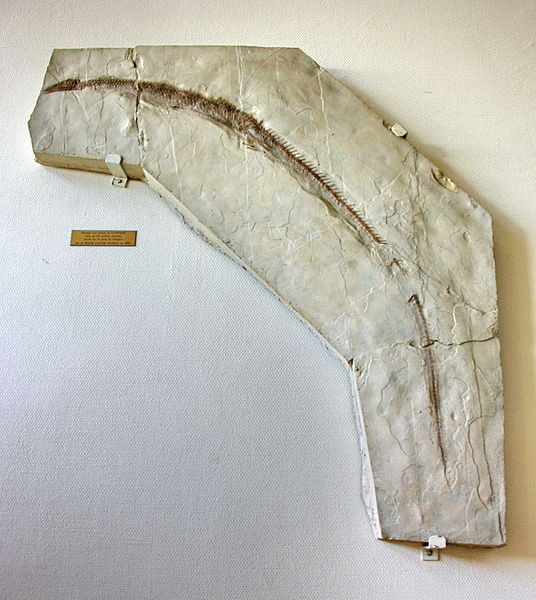
| Sphenodontia | ||
| The Vertebrates | Pleurosauridae |
| Vertebrates Home | Vertebrate | Vertebrate |
|
Abbreviated Dendrogram
|
Contents
Overview |
 |
| Pleurosaurus goldfussi, a pleurosaur from the late Jurassic of Germany and France; artwork by Nobu Tamura, Wikipedia |
The pleurosaurs were an extraordinary group of mostly European, Jurassic to Early Cretaceous, sphenodontids. Evolving from terrstrial forms during the Early Jurassic, by the ned of teh period they had attained a very specialised, serpentine form, remarkably similar to other aquatic amphibians and especially reptiles. The body was elongated and the legs small, so most of the propulsion was provided by the very long tail. The pleurosaurs were not the only aquatic sphenodontia, there is also the mid Cretacous possible Eilenodontine Ankylosphenodon from Mexico
Pleurosaurs have traditionally been placed in their own family, the Pleurosauridae, and were thought to have diverged from the rest of the sphenodontians very early. Cladistic analysis incorporating the more recently discovered transitional form Palaeopleurosaurus shows in fact that they are highly specialised descendants of more typical sphenacodontids, although the representative genus Pleurosaurus bears very little resemblance to its terrestrial ancestors. Only three species are known to date, the early Jurassic Palaeopleurosaurus posidoniae, the late Jurassic Pleurosaurus goldfussi, and the early Cretaceous P. ginsburgi perhaps representing an anagenetic lineage. MAK120706
 |
| The basal pleurosaur Palaeopleurosaurus posidoniae, Toarcian of Bavaria. Specimen in the Staatliches Museum für Naturkunde, Stuttgart. Photograph by Ghedoghedo, Wikipedia |
Pleurosauridae: Palaeopleurosaurus; Pleurosaurus.
Early Jurassic to Early Cretaceous of Europe (Central Laurasia).
traditionally Rhynchocephalia : Sphenodontidae + *. , but now: Stem Group Sphenodontinae : Homoeosaurus + (Sapheosaurus + Sphenodontinae) + *
Elongated (<58 vertebrae.) with long tail; acrodont teeth; incomplete lower temporal bar. Marine, progressive reduction of limbs (normal structure).
ATW
Comments: These highly specialised animals (convergent with many Triassic marine reptiles) were previously considered a very early offshoot of the sphenodoontian lineage. More recent cladograms, e.g. Reynoso 2000, Apesteguía & Novas 2003, and Arantes et al 2009 place Palaeopleurosaurus (and hence Pleurosauridae) within the Sphenodontidae, making the latter a paraphyletic taxon as originally defined MAK101016
Were we to follow a strictly cladistic nomenclature we would have to subsume Pleurosauridae under Sphenodontidae, to avoid the latter becoming a paraphyletic taxon. Such an approach would obscure the unique and very distinctive nature (both ecologically and morphologically) of the pleurosaurs in relation to the more generalised sphenodontids. Acknowledging the need for an inclusive taxonomic as well as phylogenetic approach, the current author (MAK) disagrees with the anti-Linnaean paradigm advocated by many vertebrate paleontologists, and prefers to retain the family ranking for Pleurosauridae as a highly distinct offshoot of the main sphenodontid lineage. MAK120706
Early Jurassic (Toarcian) of Bavaria
Pleurosauridae : Pleurosaurus + *.
Comments: Intermediate between terrestrial sphenodontids amd aquatic pleurosaurs. Both stratigraphically and morphologically, this is a fully transitional form. Reveals theat pleurosaurs are derived sphendodontids, rather than primnitive sphenodontians. This shows how difficult it is to place highly specialised taxa in cladograms, if their original synapomorphies have been lost or highly modified. The present author would argue that highly derived forms as mesosaurs and placodonts are certainly much more advanced than their apparent basal position on cladograms (as basal parareptiles and basal sauroptyerguia respectively) would seem to indicate MAK120706

Late Jurassic Kimmeridgian (Lithographic Stone) ; Bavaria, and Cerin, France., Early Cretaceous..
Pleurosauridae : Palaeopleurosaurus + *.
From Zittel/Eastman/Woodward 1902 (copyright expired): "Body serpentiform, upwards of 1.5 meters long, the tail forming one-third the total length. Snout tapering in front. Presacral vertebrae with stout single-headed ribs ; abdominal ribs well developed.Fore-limbs shorter than the hinder pair.
Comments: Prior to the discovery of Palaeopleurosaurus, the exact relationship of these highly specilaise danimals was ubnknown. In size and gross morphology, and doubtless habits, these animals are very similar to other medium-sized serpentine, aquatic, Paleozoic and Mesozoic amphibians and reptiles, such as embolomeri, younginiformes, thalattosaurs, basal ichthyosaurs, pachypleurosaurs, and agilosaurs. MAK120706
Image: Pleurosaurus sp. Canjuers, France. Photo by Michel Royon, GNU Free Documentation License. Creative Commons Attribution Share Alike, Wikipedia
page MAK120706
Using this material. All material by ATW is public domain and may be freely used in any way (also any material jointly written by ATW and MAK). All material by MAK is licensed Creative Commons Attribution License Version 3.0, and may be freely used provided acknowedgement is given. All Wikipedia material is either Gnu Open Source or Creative Commons (see original Wikipedia page for details). Other graphics are copyright their respective owners